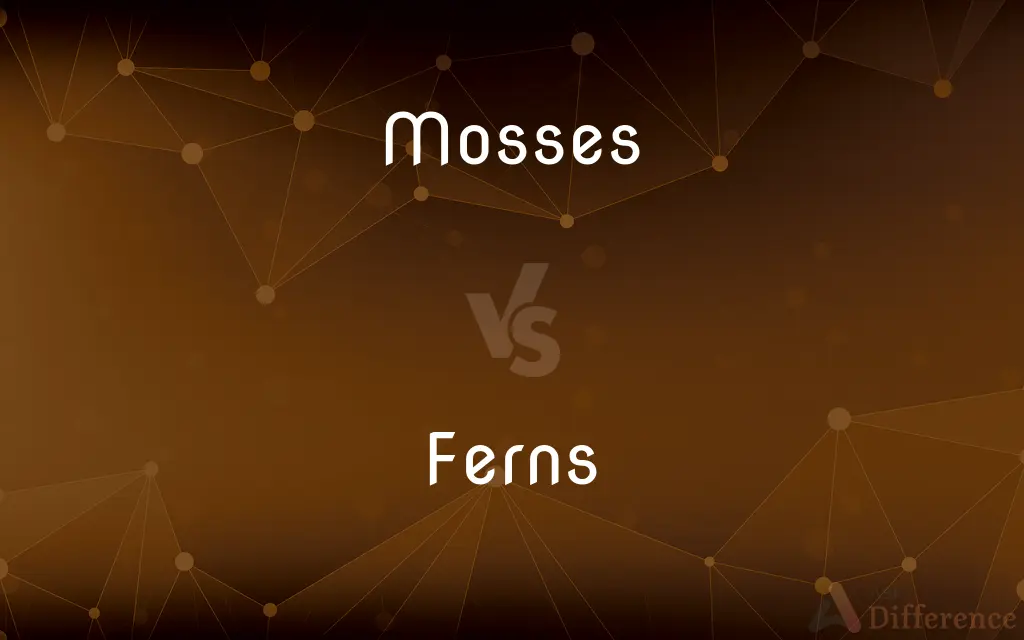Mosses vs. Ferns — What's the Difference?
Edited by Tayyaba Rehman — By Fiza Rafique — Published on November 26, 2023
Mosses are small, non-vascular plants that reproduce via spores and lack flowers or seeds, while Ferns are vascular plants with large fronds, reproducing through spores but not producing flowers or seeds.

Difference Between Mosses and Ferns
Table of Contents
ADVERTISEMENT
Key Differences
Mosses and Ferns, both non-flowering plants, have made their mark in botanical history due to their unique reproductive and growth processes. Mosses belong to the bryophyte group and are usually small, herbaceous plants. They lack a vascular system, meaning they don't have vessels to transport water and nutrients. On the other hand, Ferns are part of the pteridophyte group, and while they too reproduce via spores, they boast a developed vascular system that aids in transporting water and nutrients.
Mosses typically have a simple structure. They spread in carpet-like formations on forest floors, walls, or rocks, absorbing water directly through their leaves. Ferns, by contrast, display a more intricate design. Their large, feather-like fronds distinguish them, and they often grow in various habitats from tropical regions to temperate zones.
The life cycles of Mosses and Ferns also present distinct differences. Mosses have a dominant gametophyte stage, wherein the main plant body is haploid. Their sporophyte, or the spore-producing phase, is dependent on the gametophyte for nourishment. Ferns operate differently, with a dominant sporophyte stage, wherein the main plant is diploid, and the gametophyte, though independent, is much reduced and short-lived.
It's fascinating to note that while both Mosses and Ferns produce spores for reproduction, their mechanisms differ. Moss spores typically form in capsules at the end of slender stalks and are dispersed upon maturity. Ferns produce spores underneath their fronds in tiny structures called sporangia, which release the spores when they mature.
Although Mosses and Ferns might appear similar at first glance due to their lack of flowers and seeds, a closer look reveals substantial differences in structure, habitat, and reproduction. These plants, with their evolutionary significance, offer insights into the plant kingdom's diversity and complexity.
ADVERTISEMENT
Comparison Chart
Group
Bryophytes
Pteridophytes
Vascular System
Lack a vascular system
Have a developed vascular system
Size & Structure
Small, carpet-like formations
Large with feather-like fronds
Dominant Life Stage
Gametophyte (haploid)
Sporophyte (diploid)
Spore Production
In capsules on slender stalks
Underneath fronds in sporangia
Compare with Definitions
Mosses
Simple plants that absorb water through their leaves.
Mosses thrive in moist environments because of their direct water absorption.
Ferns
Members of the pteridophyte group, ancient in origin.
Ferns have been around for millions of years, even before flowering plants.
Mosses
Small, non-vascular plants without seeds or flowers.
Mosses often cover the forest floor, providing a soft carpet.
Ferns
Vascular plants with large, divided leaves called fronds.
Ferns added elegance to the garden with their intricate fronds.
Mosses
Bryophytes that reproduce using spores.
Mosses have tiny capsules that release spores into the environment.
Ferns
Non-flowering plants that reproduce using spores.
Ferns, despite not producing flowers, have a unique charm in their frond design.
Mosses
Non-flowering plants that often grow on rocks, trees, or soil.
The old brick wall was adorned with patches of mosses.
Ferns
Plants often found in moist, shaded locations.
The dense forest was filled with various species of ferns.
Mosses
Plants that form green, carpet-like growths.
Mosses covered the ancient stone, giving it an enchanting appearance.
Ferns
Non-seeded plants with feather-like leaves.
Ferns gracefully lined the pathway, swaying with every breeze.
Mosses
Any of various green, usually small, nonvascular plants of the division Bryophyta, having leaflike structures arranged around the stem and spores borne in a capsule.
Ferns
Any of numerous flowerless, seedless vascular plants that produce spores giving rise to free-living gametophytes and that often have dissected leaves.
Mosses
A patch or covering of such plants.
Ferns
Plural of fern
Mosses
Any of various other unrelated plants having a similar appearance or manner of growth, such as Irish moss, Spanish moss, and the club mosses.
Mosses
To cover with moss.
Mosses
Plural of moss
Mosses
Infl of moss
Common Curiosities
How do Ferns reproduce?
Ferns reproduce via spores, not seeds.
Do Mosses have flowers?
No, Mosses do not produce flowers or seeds.
How do Mosses obtain nutrients?
Mosses absorb water and nutrients directly through their leaves.
Do Ferns have a vascular system?
Yes, Ferns have a developed vascular system.
What is the primary structure of Ferns?
Ferns have large, divided leaves known as fronds.
Are Mosses smaller than Ferns?
Generally, yes. Mosses are typically small, while Ferns can be much larger.
What's the main habitat for Ferns?
Ferns thrive in various habitats, especially in moist and shaded locations.
Where are Mosses commonly found?
Mosses are often found in moist environments like forest floors, rocks, and walls.
Are Mosses vascular plants?
No, Mosses lack a vascular system.
Do Ferns form carpet-like formations like Mosses?
No, Ferns grow with distinct feather-like fronds, unlike the carpet formations of Mosses.
Share Your Discovery

Previous Comparison
Ice Skating vs. Skiing
Next Comparison
Dispersed Phase vs. Dispersion MediumAuthor Spotlight
Written by
Fiza RafiqueFiza Rafique is a skilled content writer at AskDifference.com, where she meticulously refines and enhances written pieces. Drawing from her vast editorial expertise, Fiza ensures clarity, accuracy, and precision in every article. Passionate about language, she continually seeks to elevate the quality of content for readers worldwide.
Edited by
Tayyaba RehmanTayyaba Rehman is a distinguished writer, currently serving as a primary contributor to askdifference.com. As a researcher in semantics and etymology, Tayyaba's passion for the complexity of languages and their distinctions has found a perfect home on the platform. Tayyaba delves into the intricacies of language, distinguishing between commonly confused words and phrases, thereby providing clarity for readers worldwide.













































